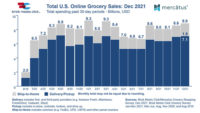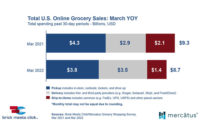US Plant-Based Food Retail Sales Hit $7.4 Billion, Outpacing Total Retail Sales
Diversifying a food system with plant-based meat, dairy, and eggs provides an opportunity for sustainable food system security in a retail world shaken by supply-side volatility and inflation

Amidst turbulent economic conditions amplified by the pandemic, supply chain issues, and inflation, new data released today by the Plant Based Foods Association (PBFA), The Good Food Institute (GFI), and SPINS, shows US retail sales of plant-based foods grew 6.2% in 2021 over a record year of growth in 2020, bringing the total plant-based market value to an all-time high of $7.4 billion. Overall, plant-based food retail sales grew three times faster than total food retail sales, with most plant-based categories outpacing their conventional counterparts. Meanwhile, the conventional protein market has been rocked by supply chain disruptions and escalating inflation. Conventional meat dollar sales grew three times faster than its unit sales over the past three years, indicating that the apparent growth is driven solely by price hikes.
Plant-based milk's share continues to grow
Plant-based milk dollar sales grew 4% and 33% in the past three years to reach $2.6 billion —while animal-based milk sales declined 2% in 2021. Plant-based milk, which now accounts for 16% of all retail milk dollar sales, is the growth engine of the milk category, contributing $105 million in growth, while animal-based milk's decline equated to a loss of $264 million. In the Natural Enhanced Channel, plant-based milk represents 40% of all milk sold, up from 34% in 2018. Forty-two percent of households purchase plant-based milk, and 76% of plant-based milk buyers purchased it multiple times in 2021.
As the largest category in the plant-based market, plant-based milk continues to benefit from product innovation and expanded merchandising space and assortment. Almond milk is the category leader, accounting for 59% of the total category, and oat milk growth is the second-largest segment, growing more than 44 times in the past three years, now making up 17% of category sales, up from only 0.5% in 2018. Plant-based milk now serves as the innovation leader in the milk category, supported by key advancements in ingredient diversification and product development to improve taste, functionality, and nutrition.
The success of plant-based milk has laid the groundwork for major growth in other plant-based dairy products, which reached $2.1 billion in total sales in 2021. Categories like ready-to-drink beverages, and plant-based creamers—which now has a 9% share of all creamers sold— experienced rapid growth as plant-based milk consumers increasingly entered these adjacent categories. Across the store, plant-based dairy dollar sales are growing faster than those of many conventional animal products. In 2021, plant-based yogurt dollar sales grew 9%, three times the rate of conventional yogurt, to a 4.5% dollar share. Plant-based cheese grew 7%, while conventional cheese declined 2%; and plant-based ice cream and frozen desserts grew 31% over the past two years to reach $458 million. In the Natural Enhanced Channel—where retail trends start—dollar share of plant-based creamers grew to 33% of all creamers sold, while plant-based yogurt grew to a 21% share of all yogurt.
Plant-based meat laps a record year
After record growth in years prior, 2021 plant-based meat dollar sales remain strong, delivering a repeat year of $1.4 billion in sales, and growing 74% in the past three years, outpacing conventional meat by almost three times. The unit comparison is even more striking—while conventional meat unit sales have grown 8% in the past three years, plant-based meat unit sales have outpaced that by more than six times, growing 51% during the same period. In 2021, plant-based meat's dollar share was 2.7% of retail packaged meat sales, or 1.4% of the total meat category (including random weight meat). Each of these plant-based meat share numbers increased 19% over the last two years. Plant-based meat's share of meat in the Natural Enhanced Channel is now 14%. Nineteen percent of households purchased plant-based meat in 2021, up from 18% in 2020, with 64% of buyers purchasing plant-based meat more than once throughout the year.
Plant-based burgers continue to lead the plant-based meat category as the top-selling product type. At the same time, the industry is responding to consumer desire for more variety within the meat category. The fastest-growing plant-based meat product types in 2021 were plant-based meatballs, chicken nuggets, tenders, and cutlets, and deli slices. In fact, plant-based chicken was a growth leader in 2021 as more products that match the taste, texture, and appearance of animal-based chicken hit retail shelves. There remains a significant ongoing opportunity in plant-based seafood, which grew 14% to $14 million, but accounts for just 1% of the plant-based meat market, compared to conventional seafood composing a fifth of total meat and seafood sales.
In the past few years, the food industry has seen multiple supply chain disruptions and broad volatility. Notably, after an overstimulated 2020, the unit sales of almost every single animal-based category experienced negative growth in 2021, and to a lesser extent, so did a couple of select plant-based categories. Conventional meat dollar sales increased three times faster than its unit sales over the past three years—this is inflation in a nutshell—indicating that apparent growth is driven by higher unit prices. And IRI's inflation index shows that in March 2022, US retail conventional meat price per unit was up 13% compared to March 2021, while plant-based meat price per unit was down 2%. With the rapid scale-up of the plant-based industry, plant-based products may soon be able to compete with animal products on price, further stimulating consumer demand.
Plant-based eggs continue rapid growth
The plant-based egg category also grew rapidly in 2021 with a 42% increase in dollar sales. In the past three years, plant-based egg dollar sales have grown more than 1000%. And with conventional egg dollar sales declining by 4% in 2021, plant-based eggs have grown to earn a nearly 0.6% share of the total egg market, compared to a 0.05% share three years ago, making plant-based eggs a growth driver of the category.
High demand from consumers with increasing purchasing power
Sixty-two percent or 79 million US households are now buying plant-based products. This is an increase from 61% (77 million in 2020). Increased repeat rates in plant-based foods across numerous record-breaking years illustrate strong consumer commitment and interest—the percentage of consumers purchasing multiple times within the plant-based category grew from 78% in 2020 to 79% in 2021. Millennials and Gen Z, which compose 47% of the population and will continue to grow in their spending power, have particularly high demand for plant-based foods. These generations are also increasing their ecommerce spending the most—and ecommerce sales of total plant-based foods grew 47% in the last year to $351 million, up from $240 million in 2020. Consumers, particularly Millennials and Gen Z, are motivated by an interest in foods that are better for their health and deliver on positive environmental impact and social responsibility. Plant-based foods are uniquely positioned to meet these consumer needs, and brands and retailers are swiftly responding to these trends and offering innovative new products and solutions.
PBFA senior director of retail partnerships Julie Emmett: "The sustained rise in the market share of plant-based foods is remarkable, and makes it clear that this shift is here to stay. More and more consumers are turning to plant-based options that align with their values and desire to have a positive impact on personal and planetary health. The data shows that, despite the challenges of the past two years, retailers and foodservice providers are meeting consumers where they are by partnering with brands across the entire store to expand space, increase assortment, and make it easier than ever to find and purchase plant-based foods. The potential impact of these initiatives extends far beyond the store shelf: By taking consumer concerns to heart, the industry is actively embracing its role as a key driver of change that moves us closer to a secure and sustainable food system.
GFI Research and Analysis Manager Karen Formanski: "Product innovation is critical for plant-based categories to continue to earn a larger share of the market. Getting more consumers to eat plant-based foods more often requires improved taste and texture to compete with animal products, more product diversity, and greater affordability and accessibility. As businesses recognize the staying power of plant-based foods, the food industry must seize these opportunities to maximize the vast potential of plant-based alternatives to compete with animal products."
SPINS Chief Commercial Officer Jay Lovelace: "Just when retailers were getting ahead of challenges from the pandemic and supply chain issues, record inflation is causing them to look at alternatives to help consumers manage their shopping and wellness journeys. SPINS data shows that plant-based products appear to be managing the economic issues in the US better than many traditional retail products. This is a trend we expect to continue throughout this year and encourage retailers to look to expand shelf space for all plant-based products."
Methodology
Point-of-sale data:
To size the US retail market for plant-based foods, GFI and PBFA commissioned retail sales data from the market research firm SPINS. The firm built the dataset by first pulling in all products with the SPINS "plant-based positioned" product attribute. The dataset was further edited by adding plant-based private label categories and subcategories, and refining the plant-based eggs category. Inherently plant-based foods, such as chickpeas and kale, are not included. Due to the nature of these categories, the retail data presented in this report may not align with standard SPINS categories. SPINS obtained the data over the 52-week, 104-week, 156-week, and 208-week periods ending December 26, 2021, from the SPINS Natural Enhanced and Conventional Multi Outlet (powered by IRI) grocery channels. SPINS defines these channels as follows:
• Conventional Multi Outlet (MULO): More than 104,000 retail locations spanning grocery, drug, mass, dollar, military, and club.
• Natural Enhanced: More than 1,800 full-format stores with $2 million+ in annual sales and 40 percent or more of UPC coded sales from natural/organic/specialty products.
This is generally considered the broadest available view of retail food sales, although not all retailers are represented. Some companies, such as Whole Foods Market, Trader Joe's, and Costco, do not report their scan data to SPINS or IRI.
Looking for a reprint of this article?
From high-res PDFs to custom plaques, order your copy today!






